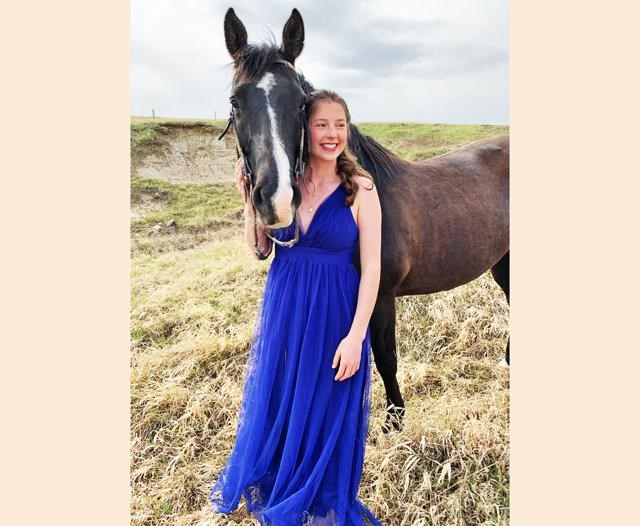Weyburn Comprehensive School graduate Arliss Sidloski is entering the College of Engineering this fall, and was named one of two University of Saskatchewan recipients of the Schulich Leader Scholarship of $100,000 earlier this year. She is excited to be starting her engineering program, which includes a place on the university’s Space Team.
Sidloski was selected for her outstanding academic achievements in science and her community work to support children with special needs. In 2019, she helped start an all-abilities soccer program and was captain of her high school soccer, basketball and cross-country teams.
Sidloski said she’s excited to learn about the different aspects of engineering in the coming years, and this summer, joined the University of Saskatchewan Space Teamto design and prepare a cube-satellite for orbital launch in late 2021. It will be Saskatchewan’s first satellite in space.
“As of late July, I am an official member at the University of Saskatchewan Space Team (USST). The recruitment process generally begins at the start of the school term, but I was so intrigued by the idea of designing a satellite that I got in contact with them in July so that I could get started on the project right away,” she said.
“I am a member of the systems sub-team and so assist in ensuring proper integration of components, completion of crucial documentation, and testing of components,” she added.
The other sub-teams for this project consist of mechanical, payload, software, power and electrical, comms and data handling, and attitude determination and control systems.
“I am so fortunate to be going to the University of Saskatchewan where opportunities like this are possible. Though I am only beginning my first year of studies, working on the RADSAT-SK project is providing me with a real-world experience of what it is like to be an engineer,” said Sidloski.
In regard to being named a Schulich Leader, she said, “It is humbling to be honoured with the prestigious Schulich Leader Scholarship and join the community of other high-achieving award recipients. I am filled with gratitude that Mr. Schulich and his foundation have provided me with this opportunity.”
Through the Schulich Foundation, these entrance scholarships are awarded to 100 high school graduates this year, enrolling in a science, technology, engineering or mathematics (STEM) undergraduate program at 20 partner universities in Canada, including USask.
Every high school in Canada can submit one Schulich Leader nominee per academic year based on academic excellence in STEM, entrepreneurial leadership and financial need. Out of a pool of 350,000 potential candidates across Canada, 1,400 students were nominated, and this year, 100 students received the award, up from 50 in prior years.
Recognizing the increasing importance and impact that STEM disciplines will have on the prosperity of future generations, businessman and philanthropist Seymour Schulich established this $100+ million scholarship fund in 2012 to encourage the best and brightest students to become Schulich Leader Scholars, who are the next generation of entrepreneurial-minded, technology innovators.
The satellite is a joint project between the University of Saskatchewan and the U of S Space Design Team (USST), Saskatchewan Polytechnic and the Canadian Space Agency.The cube satellite, known as RADSAT-SK, is a 2U cubesat, meaning it measures 20x10x10 cm. Fitting everything needed into this small form-factor is just one of the many engineering problems the team must develop solutions for.
The cube satellite has three technical objectives, the first being the validation and testing of a new type of radiation dosimeter being developed by faculty at the College of Engineering.
This new type of sensor is much smaller and cheaper than current space-grade dosimeters. Along with the dosimeter the team will also be testing the use of high-concentration melanin as a radiation shield in space. This research is also being conducted at the U of S by faculty at the college of pharmacology.
Lastly, RADSAT-SK will have an earth-imaging camera on-board in the hope that the team can capture some images of Saskatchewan from space that can be shared with the province.
RADSAT-SK’s scheduled launch date is for sometime in late 2021, however, space flight is a tricky business and it’s possible that the launch date may be pushed back to 2022 or later.
Once it’s ready, the satellite will be flown to the International Space Station via a launch in the U.S. where it will then be handled by astronauts and loaded into a specially-designed launcher for CubeSats. Once in place, the satellite will then be shot into orbit by the launcher and will orbit for approximately one year.
In the spirit of USST tradition, the RADSAT-SK satellite is designed, constructed, and will be operated by students from both the U of S and SaskPolytech. Since this project is so large in scale, the team has a faculty supervisor that assists with project management and finances, and they regularly communicate with the CSA and other consultants to aid with the design of the satellite.
Sidloski noted the RADSAT-SK differs from the CubeSat projects at the other Canadian universities as it is being designed and documented only by undergraduate students. All other CubeSat projects have master students and faculty that are assisting in the development for their designs.
“The only faculty member on our RADSAT-SK is our principle investigator, Professor Sean Maw, who stays up to date on our progress and signs off on crucial documentation that would not be accepted by a student, but he does not assist in the design or integration of the RADSAT-SK,” she said.




